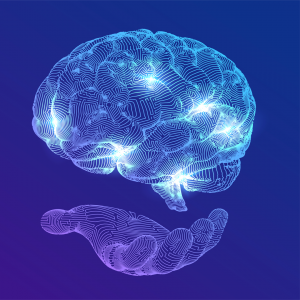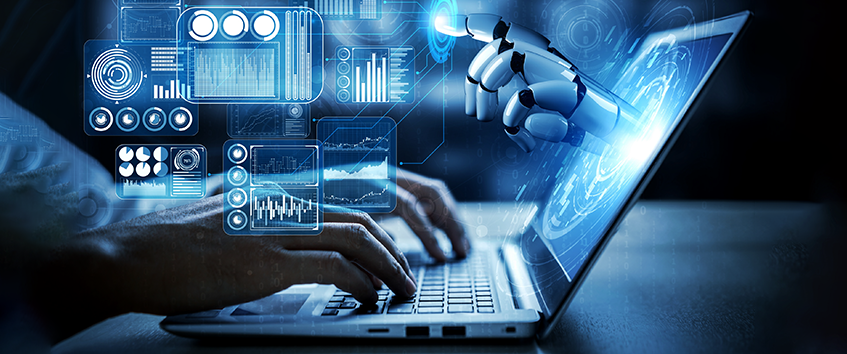ArtificiaI Intelligence: The Digital Hero
March 16, 2023
The science of Artificial Intelligence (AI) is constantly advancing and transforming our lives and work. AI is transforming how we engage with technology, from chatbots and virtual assistants to robots and self-driving automobiles. Things that are seen as “clever” can be done by AI.
AI, or artificial intelligence, is the process by which robots, particularly computer systems, mimic human intelligence. It entails the creation of computer programs and algorithms that are capable of carrying out operations that ordinarily call for human intelligence, such as learning, problem-solving, and decision-making. In addition, AI is utilized in a variety of industries, including healthcare, banking, and marketing, to increase efficiency and accuracy in numerous operations. Some of the most popular AI applications include chatbots and recommendation systems. AI has numerous applications, including expert systems, NLP, speech recognition, and machine vision.
Although AI has been around for a while, recent improvements in computing power, data storage, and machine-learning techniques have allowed the discipline to expand significantly. The way machines learn and analyze data has been revolutionized by the introduction of deep learning neural networks, which are designed after the human brain. Because these neural networks can learn and get better over time, they are ideal for applications that call for pattern identification and prediction.
Components of AI
Artificial intelligence can provide businesses and organizations with information about their daily operations that they wouldn’t normally have. Artificial intelligence programs may assist business, educational institutions, and healthcare facilities to complete tasks more quickly and efficiently than humans.
To understand how AI works, it is necessary to understand each component of AI. Here are some major components of AI:-
Machine Learning: The practice of teaching machines to learn from data is known as machine learning (ML), which is a subset of artificial intelligence. On the basis of statistical models that locate patterns in data, machine learning algorithms create predictions. supervised learning, unsupervised learning, and reinforcement learning are the three categories of machine learning.

Deep Learning (DL): Deep learning is a type of machine learning that employs neural networks to simulate the processing of the human brain. Large amounts of data can be processed by DL algorithms, which can then learn to recognise complex patterns. This makes them especially useful for tasks like image and speech recognition.
Natural Language Processing (NLP): NLP is a category of artificial intelligence that aims to educate computers on how to comprehend and process human language. Algorithms for natural language processing are employed in projects like sentiment analysis, chatbots, and language translation.
Computer Vision (CV): Computer vision is a branch of artificial intelligence that focuses on teaching machines to interpret and analyze visual data from their surroundings. CV algorithms involves in tasks like object recognition, facial recognition, and self-driving cars.
Automated systems : Automated systems or Robotics is a branch of artificial intelligence that involves the creation of machines that can perform physical tasks. Sensors, actuators, and algorithms are used by robotic systems to interact with their environment and perform tasks like assembly, inspection, and transportation.
Expert Systems: Expert systems are artificial intelligence (AI) systems that are designed to solve complex problems in a particular domain. These systems make decisions and solve problems by applying a set of predefined rules and knowledge bases.

Knowledge Representation: Knowledge representation is an AI component that entails the creation of formal systems for representing knowledge in a machine-readable format. This enables machines to reason about complex problems and make decisions based on what they know about the world.
Time Management and Planning: Planning and scheduling are AI components that involve the development of algorithms for optimizing the use of resources and time in complex tasks. These parts are used in a variety of applications, including logistics, manufacturing, and transportation.
Decision Making: Decision making is an AI component that entails the development of algorithms for making decisions based on data and models. These algorithms are used in a variety of applications, including financial trading, healthcare, and logistics.
Machine Perception: Machine perception is an AI component that involves the development of algorithms that allow machines to perceive and interpret their environment using sensors such as cameras and microphones. These algorithms are used in applications such as self-driving cars, surveillance systems, and robotics.
Overall, the various components of AI work together to enable machines to perform tasks that would normally require human intelligence. As AI advances, these components will become more advanced and sophisticated, opening the door to new and exciting applications in a variety of industries.
Importance of Artificial Intelligence
AI is significant because, in some circumstances, it can outperform humans at tasks and because it can provide businesses with previously unknown insights into their operations. AI tools frequently finish tasks quickly and with relatively few mistakes, especially when it comes to repetitive, detail-oriented tasks like analyzing a large number of legal documents to ensure relevant fields are filled in correctly.

This has contributed to an explosion in productivity and given some larger businesses access to completely new market opportunities. It would have been difficult to imagine using computer software to connect passengers with taxis before the current wave of AI, but today Uber has achieved global success by doing just that. It makes use of sophisticated machine learning algorithms to forecast when individuals in particular locations are likely to require rides, which assists in proactively placing drivers on the road before they are required.
The biggest and most prosperous businesses of today have used AI to enhance their operations and outperform rivals.
Trends in AI – Text, Speech and Vision
AI for text involves natural language processing techniques to analyze and understand human language. It involves tasks like language translation, sentiment analysis, language generation, and more. Some popular AI models for text include BERT, GPT, and Transformer models.
AI for speech involves using techniques such as speech recognition, speech synthesis, and speaker identification. This technology is used in virtual assistants, automated call centers, and speech-to-text transcription software. Some popular AI models for speech include DeepSpeech and Kaldi.
AI for vision involves using techniques like image recognition, object detection, and image classification to understand visual data. Also used in applications like self-driving cars, facial recognition, and medical imaging. Some popular AI models for vision include YOLO, RCNN, and AlexNet.
Factors Driving AI Adoption in Business
Data Explosion: The massive amount of data being generated daily are becoming increasingly difficult to manage and analyze it manually. AI can help businesses extract valuable insights and patterns from this data, providing a competitive advantage.
Increased Computing Power: The increased availability of computing power has enabled the development of more complex AI models that can process and analyze data faster and more accurately than ever before.
Improved Algorithms: Advancements in AI algorithms, such as deep learning and reinforcement learning, have made it possible for machines to learn and improve their performance over time.
Cost Reduction: AI technologies have become more affordable and accessible, enabling even small and medium-sized businesses to benefit from them.
Enhanced Customer Experience: AI-powered chatbots, virtual assistants, and recommendation systems can improve the customer experience by providing personalized recommendations and 24/7 support.
Automation: AI can automate routine tasks, freeing up employees time to focus on more valuable tasks and increasing productivity.
Overall, AI is becoming increasingly essential for business to remain competitive in today’s data-driven economy.
10 Amazing Facts About AI
- According to International Data Corporation (IDC), the spending on AI will be expected to surpass $50 billion by 2025.
- According to Statista, revenue from the Artificial Intelligence (AI) software market worldwide is expected to reach 126 billion dollars by 2025.
- As reported by Gartner, by 2025, more than 75% of venture and seed capital investors will use AI and data analytics to gather information.
- Alphabet’s Google and Nvidia are two of the world’s top most innovative AI companies.
- The world’s top universities have increased their AI-related education over the last few years, according to the AI Index.

- Experts believe that AI will take over 16% of current jobs within the next 10 years, but worry not, a new era of job opportunities will arise.
- AI is used in the surgery not only for diagnosing patients but also for decision-making and automated (robot-assisted) surgeries.
- The contribution of AI to the global economy is projected to hit $15.7 trillion by 2030.
- The top five countries/regions for AI engineers are the USA, Europe, China, Canada, and India.
- Google has a Quantum AI Lab where, unlike other companies, they actually own a quantum computer.
Major tips to successfully implement AI
Define Clear Objectives: Before implementing AI, define clear objectives for what you hope to achieve. This will help you identify the most appropriate AI tools and applications to use, as well as measure the success of your AI initiatives.
Identify the Right Data: AI relies heavily on data, so it is important to identify the right data sources and ensure data quality. Make sure the data you are using is accurate, complete, and relevant to the problem you are trying to solve.
Work with Experienced AI Professionals: Implementing AI requires a high level of technical expertise, so it is important to work with experienced AI professionals. Consider partnering with an AI consultancy or hiring AI experts to help you implement and manage your AI systems.
Hire the right talent: Implementing AI requires specialized skills. Hire the right talent to help you develop, deploy, and manage your AI systems. Look for individuals with expertise in machine learning, data science, and computer engineering.
Ensure regulatory compliance: AI is subject to various regulations, such as privacy and data protection laws. Ensure that your AI systems comply with all applicable regulations.

The major reason for the rapid evolution of artificial intelligence is its ability to process large amounts of data much faster and make better predictions than humans. There are a number of drawbacks and concerns associated with AI, despite its potential benefits. The following are some of the major drawbacks of AI:
Employment Dispersion: One of the most serious concerns about the use of AI is the potential for widespread job displacement. Many people may lose their jobs as machines become more capable of performing tasks that performed by humans. This can have serious economic and social consequences, particularly for low-skilled workers.
Lack of Emotional Intelligence: While AI is good at performing tasks that require logic and analysis, it lacks emotional intelligence. Machines are not capable of understanding human emotions or empathizing with people in the way that humans can. This can limit the effectiveness of AI in certain applications, such as customer service or counseling.
Discrimination and bias: AI systems are only as good as the data on which they are trained. The AI system may make incorrect or unfair decisions if the data is biased or incomplete. There have been several high-profile cases of AI systems displaying bias or discrimination, most notably in facial recognition technology and hiring algorithms.
Dependence on Technology: As AI becomes more prevalent in our daily lives, there is a risk that we become overly dependent on technology. This can make us more vulnerable to cyber attacks and other technological failures.
Lack of Creativity: AI is good at performing tasks that are repetitive or require logical analysis, but it lacks creativity. Machines are not capable of coming up with truly original ideas or solutions in the way that humans can.
Safety and Privacy Concerns: As AI grows more popular, there are concerns regarding the security and privacy of personal data. Because AI systems require a lot of data to operate, there is a chance that personal data will be misused or breached.
Cost: Building and implementing AI systems can be expensive, especially for startups and small firms. There may be large upfront expenditures associated with training and installing AI systems, which may be prohibitive for some enterprises. So it will be a major threat to AI.
In Essence,
Artificial Intelligence allows machines to mimic or approximate human intelligence (AI). With the use of computers, AI attempts to improve our capacity for learning, reasoning, and perception. Artificial intelligence is now in a variety of fields, including banking and healthcare. Some detractors claim that under some circumstances, career opportunities for humans may suffer as a result of advanced AI.
If you’re in search of a marketing company, just contact Monolith. With the help of AI-powered technology, we can provide you with the best possible digital marketing solutions to achieve your business objectives.
